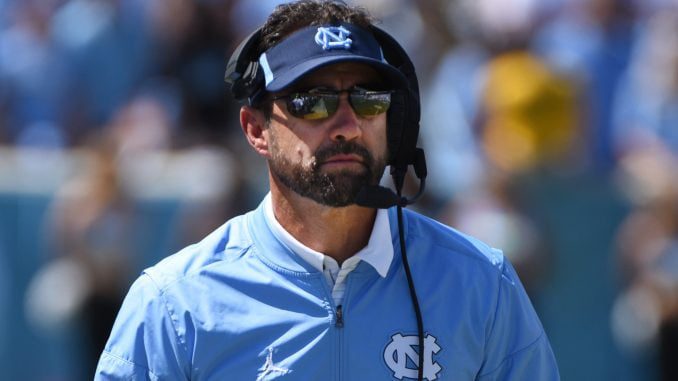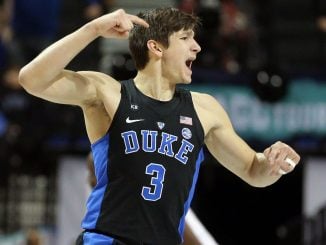
NC State coach Dave Doeren got commitments from 10 players in June, and another three in early July. When the dust settled, 13 of the top 50 prospects in the state donned a Wolfpack cap. That run included several high-profile victories over UNC, including Roxboro defensive tackle Joshua Harris and North Stanly tackle C.J. Clark.
State currently has the No. 20 recruiting class in America, according to the Scout/247Sports rankings.
North Carolina, meanwhile is No. 45, a 22-spot drop from last year.
What caused the change in fortune for both teams? Well, NC State won its bowl game in late December and sent several players, including all four defensive line starters, to the NFL. Doeren was also the subject of a very high-profile flirtation from Tennessee.
All of that appeals to college kids, who want to play for big-time coaches, win bowls and get drafted. And it all took place while UNC struggled to a disappointing 3-9 season.
Of course, that doesn’t explain everything. After all, UNC coach Larry Fedora went to the ACC Championship Game in 2015 and saw Mitch Trubisky get drafted second overall in the 2017 NFL Draft. While he was able to parlay both of those into recruiting success, it was nothing like we’re currently seeing from the Pack.
Each signing day, Fedora talks about how it’s the result of two years of relationship building with the kids. That means that the players committing now began their relationship with Fedora when the Tar Heels were winning the Coastal and sending talent to the league, and yet they’re not choosing Carolina.
There’s also the factor of NCAA trouble. For the first time since he arrived at Carolina, Fedora doesn’t have to fight rumors that the Heels might get hit with NCAA sanctions. However, Fedora doesn’t seem to be enjoying the same boost in recruiting that basketball coach Roy Williams has seen.
Plus, Carolina has recently lost battles for in-state players to the likes of Wake Forest (receiver Donavon Greene) and Duke (defensive end Christian Rorie), lending credence to concerns that it’s more than just a case of State doing things right. Duke’s class is No. 27 nationally, up from 62nd last year. Wake’s is No. 32, up 31 spots.
Is something wrong at Carolina?
Athletic director Bubba Cunningham doesn’t think so. He gave Fedora a vote of confidence last week.
“I feel great about where the program is,” Cunningham said. “I think they’ve done a great job recruiting.”
So, what exactly is happening on the recruiting trail?
After winning the Coastal, rewriting the school’s offensive record books with a high-tempo attack and being the toast of the NFL Draft, Carolina was the “it school” for talented young players.
There are two ways to parlay that kind of success on the recruiting trail. One is to continue going after the same players, in the same areas as always, and just (presumably) win more of the battles. The other is to use your new, higher profile to go after better players and expand the footprint.
Duke coach David Cutcliffe followed the latter approach after the Blue Devils won the Coastal. Cutcliffe frequently spoke about how the program’s improvement got him inside the front door of players who previously wouldn’t have considered Duke, including four-stars Ben Humphreys and Scott Bracey, who signed on in back-to-back years.
Using the 247Sports/Scout recruiting database information, it appears that Fedora took a similar approach after his run of success. The number of scholarships he offered to prospects ranked in the top 100 nationally suddenly skyrocketed.
Year: Offers to top 100s
2014: 31
2015: 37
2016: 36
2017: 47
2018: 51
2019: 29
Starting in 2017 (the players who would be the prospects Fedora’s staff started their two-year relationship with in the Coastal title year), UNC offered scholarships to nearly half the players in the Top 100.
Carolina made a total of 232 scholarship offers in 2018, meaning that more than one out of every five offers Fedora made was to a Top 100 player, compared to one in eight from the 2016 cycle.
In order to find those players, Fedora and his staff traveled farther and went deeper into the national recruiting hotbeds.
Here’s a look at UNC scholarship offers that went to players in Florida, by recruiting year:
2014: 42
2015: 54
2016: 67
2017: 94
2018: 73
2019: 46
And here are offers made to players in the Southwest and West:
2014: 11
2015: 11
2016: 22
2017: 23
2018: 21
2019: 12
And Deep SEC country (Mississippi, Alabama, Louisiana)
2014: 5
2015: 4
2016: 21
2017: 10
2018: 10
2019: 3
Clearly, Fedora felt that the Tar Heels were ready to battle the big boys. And, as a result, he shifted his attention away from traditional UNC recruiting grounds.
Virginia and South Carolina got less attention.
2014: 31
2015: 32
2016: 32
2017: 20
2018: 20
2019: 24
And, perhaps most importantly, so did North Carolina.
2014: 32
2015: 29
2016: 36
2017: 20
2018: 24
2019: 37
Prior to the ACC title, one out of every seven scholarship offers UNC extended were to in-state talent. In 2017, it was less than one out of every 13.
High school coaches notice who’s checking in with them, and how often. Fedora’s choice to go elsewhere would have registered across North Carolina.
Here’s the thing with battling the big boys: They’re hard to beat, and the big fish are harder to land. So Fedora lost a good share of those stretch recruiting battles. The result could be seen last season, when the Heels also experienced some unexpected early departures to the NFL and had to resort to graduate transfers to help fill the roster holes that resulted from being shorthanded.
It appears that Fedora learned his lesson. While it’s still early in the recruiting cycle, and more offers may be extended, it’s clear in each of the previous charts that UNC has shifted back to its old ways.
For the first time since 2014, Fedora has offered more scholarships to North Carolina players than to national Top 100 players. One out of every six scholarships offered so far has been to in-state players, which, if the numbers hold through signing day, would be the highest proportion in six years.
Fedora has already made more offers in Virginia and South Carolina than he did all of last year, and he’s scaled back in Florida, the Deep South and out West.
Plus, he’s returned to North Carolina with a vengeance, already offering more scholarships in-state than in any year since he took the head coaching job.
Which brings us back to our initial question: What’s the problem this year?
If Fedora is returning to UNC’s roots, why isn’t he being welcomed with open arms?
Possibly because there’s another school, currently on an upward trend, that never left.
Doeren took the polar opposite approach from Fedora, and Cutcliffe before him, when the Pack suddenly became the “it” school.
Here’s a look at Doeren’s offers to North Carolina players over the last three cycles.
2017: 34
2018: 30
2019: 39
Far from leaving the state for more talented pastures, Doeren has doubled down in North Carolina, already making more in-state offers than in the last two years. Rather than using his newly earned clout to expand his footprint, he’s using it to build the proverbial wall.
A look at his Top 100 offers shows just how conservatively Doeren is acting with his scholarships.
2017: 29
2018: 33
2019: 16
Is it better to roll the dice and try to reach that next level, or to play it close to the vest and stay close to home? Which approach is the correct one? Time will tell on the field. But on the recruiting trail, it appears that local high school coaches and athletes are more receptive to the program that focuses on them, rather than the one that is returning, after taking a shot at the big time.
This article was reprinted with permission from Carolina Blue Magazine.


